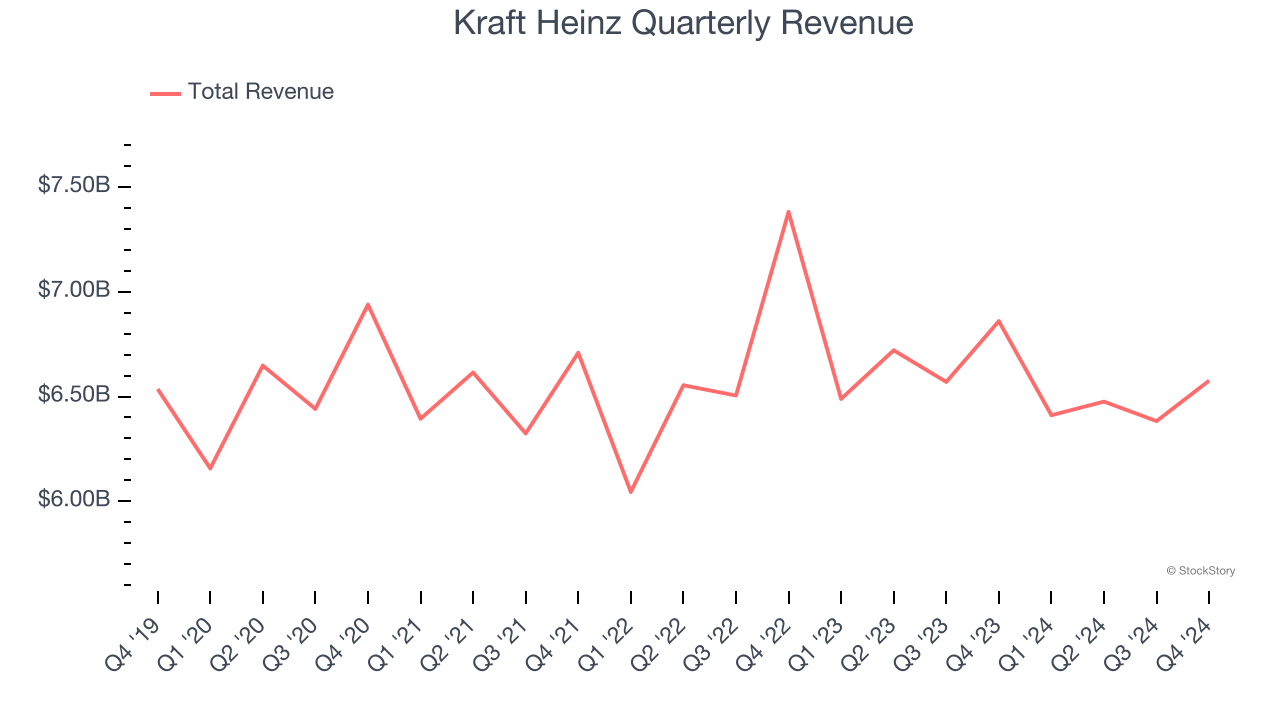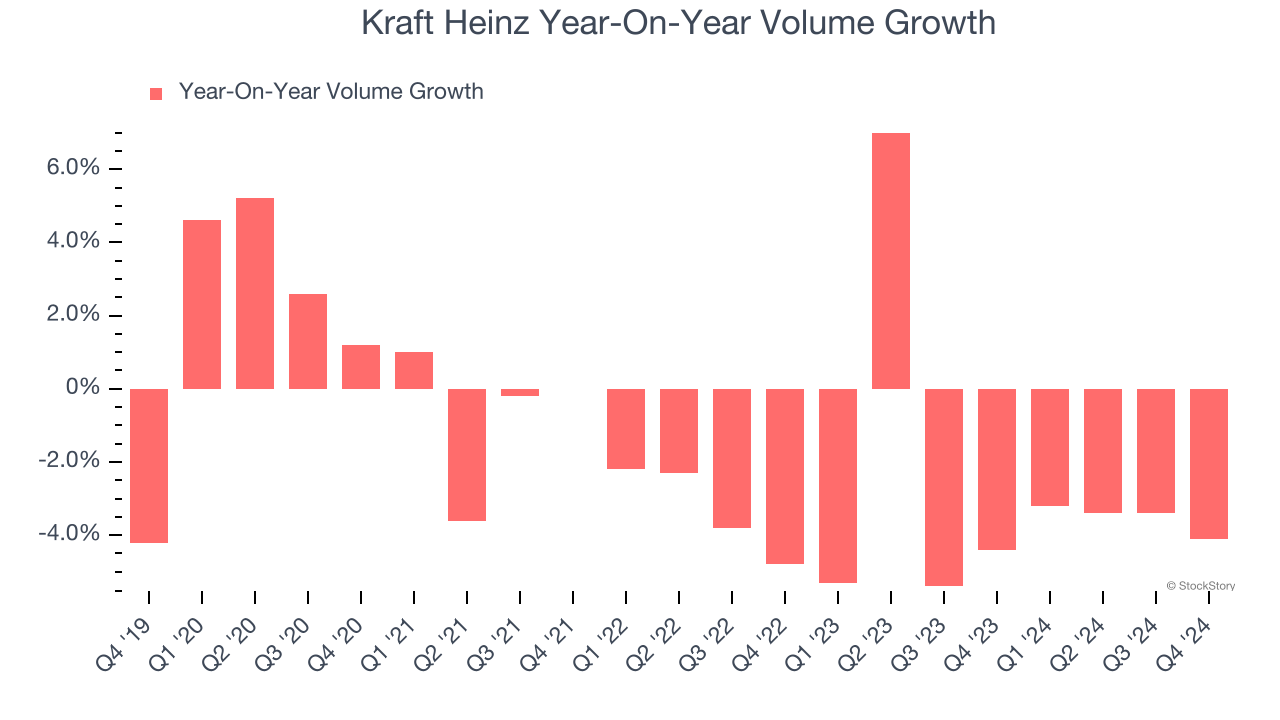
Packaged foods company Kraft Heinz (NASDAQ: KHC) fell short of the market’s revenue expectations in Q4 CY2024, with sales falling 4.1% year on year to $6.58 billion. Its non-GAAP profit of $0.84 per share was 7.8% above analysts’ consensus estimates.
Is now the time to buy Kraft Heinz? Find out by accessing our full research report, it’s free.
Kraft Heinz (KHC) Q4 CY2024 Highlights:
- Revenue: $6.58 billion vs analyst estimates of $6.66 billion (4.1% year-on-year decline, 1.3% miss)
- Adjusted EPS: $0.84 vs analyst estimates of $0.78 (7.8% beat)
- Adjusted EBITDA: $220 million vs analyst estimates of $1.65 billion (3.3% margin, 86.6% miss)
- Adjusted EPS guidance for the upcoming financial year 2025 is $2.69 at the midpoint, missing analyst estimates by 11.7%
- Operating Margin: -0.6%, down from 19% in the same quarter last year
- Free Cash Flow Margin: 17.4%, similar to the same quarter last year
- Organic Revenue fell 3.1% year on year (-0.7% in the same quarter last year)
- Sales Volumes fell 4.1% year on year, in line with the same quarter last year
- Market Capitalization: $35.77 billion
“Although 2024 was a challenging year with our top line results coming in below our expectations, we remained disciplined in protecting profitability while driving industry-leading margins, generating strong cash flow, and returning $2.7 billion in capital to stockholders,” said Kraft Heinz CEO Carlos Abrams-Rivera.
Company Overview
The result of a 2015 mega-merger between Kraft and Heinz, Kraft Heinz (NASDAQ: KHC) is a packaged foods giant whose products span coffee to cheese to packaged meat.
Shelf-Stable Food
As America industrialized and moved away from an agricultural economy, people faced more demands on their time. Packaged foods emerged as a solution offering convenience to the evolving American family, whether it be canned goods or snacks. Today, Americans seek brands that are high in quality, reliable, and reasonably priced. Furthermore, there's a growing emphasis on health-conscious and sustainable food options. Packaged food stocks are considered resilient investments. People always need to eat, so these companies can enjoy consistent demand as long as they stay on top of changing consumer preferences. The industry spans from multinational corporations to smaller specialized firms and is subject to food safety and labeling regulations.
Sales Growth
A company’s long-term performance is an indicator of its overall quality. While any business can experience short-term success, top-performing ones enjoy sustained growth for years.
With $25.85 billion in revenue over the past 12 months, Kraft Heinz is one of the most widely recognized consumer staples companies. Its influence over consumers gives it negotiating leverage with distributors, enabling it to pick and choose where it sells its products (a luxury many don’t have). However, its scale is a double-edged sword because there are only so many big store chains to sell into, making it harder to find incremental growth. To accelerate sales, Kraft Heinz must lean into newer products.
As you can see below, Kraft Heinz struggled to increase demand as its $25.85 billion of sales for the trailing 12 months was close to its revenue three years ago. This is mainly because consumers bought less of its products - we’ll explore what this means in the "Volume Growth" section.

This quarter, Kraft Heinz missed Wall Street’s estimates and reported a rather uninspiring 4.1% year-on-year revenue decline, generating $6.58 billion of revenue.
Looking ahead, sell-side analysts expect revenue to remain flat over the next 12 months. This projection doesn't excite us and implies its newer products will not catalyze better top-line performance yet.
Software is eating the world and there is virtually no industry left that has been untouched by it. That drives increasing demand for tools helping software developers do their jobs, whether it be monitoring critical cloud infrastructure, integrating audio and video functionality, or ensuring smooth content streaming. Click here to access a free report on our 3 favorite stocks to play this generational megatrend.
Volume Growth
Revenue growth can be broken down into changes in price and volume (the number of units sold). While both are important, volume is the lifeblood of a successful staples business as there’s a ceiling to what consumers will pay for everyday goods; they can always trade down to non-branded products if the branded versions are too expensive.
To analyze whether Kraft Heinz generated its growth (or lack thereof) from changes in price or volume, we can compare its volume growth to its organic revenue growth, which excludes non-fundamental impacts on company financials like mergers and currency fluctuations.
Over the last two years, Kraft Heinz’s average quarterly sales volumes have shrunk by 2.8%. This isn’t ideal for a consumer staples company, where demand is typically stable. Luckily, Kraft Heinz was able to offset fewer customers purchasing its products by charging higher prices, enabling it to maintain its organic sales. We hope the company can grow its volumes soon, however, as consistent price increases (on top of inflation) aren’t sustainable over the long term unless the business is really really special.

In Kraft Heinz’s Q4 2024, sales volumes dropped 4.1% year on year. This result represents a further deceleration from its historical levels, showing the business is struggling to move its products.
Key Takeaways from Kraft Heinz’s Q4 Results
It was encouraging to see Kraft Heinz beat analysts’ EPS expectations this quarter. On the other hand, its full-year EPS guidance missed significantly and its EBITDA fell short of Wall Street’s estimates. Overall, this was a softer quarter. The stock traded down 3.8% to $28.49 immediately after reporting.
Kraft Heinz may have had a tough quarter, but does that actually create an opportunity to invest right now? We think that the latest quarter is only one piece of the longer-term business quality puzzle. Quality, when combined with valuation, can help determine if the stock is a buy. We cover that in our actionable full research report which you can read here, it’s free.





